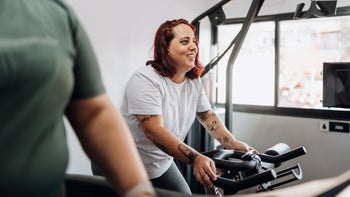
8 Common Running Injuries and How to Prevent Them, According to Medical Experts
Key takeaways:
Running is a high-impact, repetitive form of exercise. Many overuse conditions can develop without proper form or enough rest between runs.
The most common running injuries include runner’s knee, shin splints, Achilles tendonitis, and plantar fasciitis.
Simple fixes can prevent many of these conditions. These include resting between runs, running on even surfaces, and improving the strength and flexibility of your leg and hip muscles.

Running is a great form of exercise that has many cardiovascular benefits. But because running is a high-impact and repetitive movement, it can increase the risk of several injuries. Common running injuries can quickly develop, but there are steps you can take to reduce your risk. Learn more about the most common running injuries, causes, and tips for injury prevention.
What are the most common running injuries?
Running is a highly repetitive activity. Your joints and muscles move through the same cyclical patterns hundreds or thousands of times. With repeated activity like this, overuse injuries can occur.
Overuse or repetitive strain injuries develop gradually over time from high-impact and repeated stress. They are also more likely to develop if you have poor running form or muscle imbalances.
Search and compare options
1. Runner’s knee
What it is: Runner’s knee, also called patellofemoral pain syndrome, is one of the most common running injuries. This condition causes a dull, achy pain in the front of the knee. It typically develops from overuse, improper form, and muscle imbalances. Overpronation of the feet can also make this condition more likely to develop.
How to prevent it: Running with proper form can help reduce knee strain. Strengthening exercises for the quadriceps and glutes help stabilize your hips and knees. This allows for better leg alignment and prevents increased stress from being felt through the knees. Supportive footwear and orthotics can help maintain proper foot, ankle, and shin alignment.
2. Shin splints
What it is: Shin splints, or medial tibial stress syndrome, result from repeated irritation of the shin bones along the front of the lower leg. The high-impact nature of running places a lot of pressure on the shins as your feet strike the ground. Shin splints cause pain and tenderness along the front or inner side of the shin bone.
How to prevent it: Shin splints are more likely to develop when more pressure is applied through the inner edge of the foot. This occurs with excessive pronation. To combat this, orthotics and stretching your calf muscles can help maintain ankle and foot alignment. Shin splints are also associated with a sudden increase in running frequency or intensity. Gradually increasing running frequency or duration can prevent shin splints from developing or coming back.
Quiz: Do I have a stress fracture?
3. Stress fracture
What it is: Running with shin splints without proper treatment can make them worse. The continued impact can progress to a shin (tibia) stress fracture. Stress fractures are small breaks in a bone that develop over time from repeated stress. Overuse can also cause stress fractures in the bones of the feet or hips. Pain, tenderness, and swelling are common around the affected bone.
How to prevent it: Taking rest days between runs helps decrease strain and prevent stress fractures. Gradually increasing how much you run can avoid excess irritation. Wear supportive shoes, and limit running on hills or uneven surfaces to reduce the impact on your feet and shins.
Read more like this
Explore these related articles, suggested for readers like you.
4. Achilles tendonitis
What it is: The Achilles tendon connects your calf muscles to your heel and helps with movements such as walking, running, and jumping. Overuse during running and a lack of flexibility increase the strain on the Achilles tendon, up to 12.5 times your body weight. The additional strain can lead to pain and inflammation, causing tendonitis, which decreases the tendon’s ability to absorb energy. Common symptoms include pain, tenderness, and swelling along the tendon or at the back of the heel.
How to prevent it: Stretching and strengthening your calf muscles are key for preventing Achilles tendon strain. Both foot pronation and high arches can increase strain on the Achilles tendon. So supportive shoes and orthotics can help promote good joint alignment for injury prevention.
5. Pulled muscle
What it is: Pulled muscles can happen if you don’t warm up before exercise or have tight muscles and tendons. In runners, the most common ones involve the calves or hamstrings. Pain and tightness are felt along the affected muscle.
How to prevent it: Warming up before your workouts reduces the risk of muscle strain. Regularly stretching your legs will help maintain the range of motion in your muscles and joints. Correcting muscle imbalances — with stretching and strengthening exercises — ensures that your muscles are strong enough to keep up with the demands of running.
6. Plantar fasciitis
What it is: Plantar fasciitis results from irritation of the plantar fascia. This tough connective tissue runs along the bottom of the foot. Prolonged standing, walking, and running increase pressure on the plantar fascia. This can lead to sharp pain at the heel or along the arches, especially if you wear unsupportive shoes.
How to prevent it: Wearing shoes that adequately support your arches and stretching regularly are key. You may also want to get custom insoles or orthotics to support good foot alignment.
7. Ankle sprain
What it is: Ankle sprains are among the most common running injuries. They occur from twisting or rolling the ankle, which strains the ligaments that stabilize the ankle joints. Pain, swelling, and limited range of motion typically result.
How to prevent it: Improving your balance, ankle strength, and range of motion can prevent ankle sprains. Wear supportive shoes and limit running on uneven surfaces to reduce risk. If you’ve sprained your ankle once, it’s more likely to happen again. So working on your ankle stability is important to prevent further injury.
8. IT band syndrome
What it is: The iliotibial (IT) band is a long band of connective tissue that travels along the outer side of the thigh. This band connects the hip to the knee and helps provide stability. Without proper strength in the glutes, the IT band is more likely to be stressed repeatedly with running. This stress leads to pain and tenderness at the outer side of the knee that worsens with knee bending.
How to prevent it: IT band syndrome typically develops from muscle imbalances. Fixing these imbalances can prevent this condition from occurring. Hip- and glute-strengthening exercises as well as IT band stretching can help. These exercises can help correct muscle imbalances, improve alignment, and reduce IT band strain. You can also try cross-training to reduce repeated strain with running.
Get started on the right foot. Learn eight beginner-friendly tips on how to run.
Warm up before every run. These dynamic stretches can make running easier, safer, and more effective.
Focus on your form. Techniques for proper running form may lower your risk of injury.
Remember to cool down. Light cardio and static stretches after running help you recover faster.
Should you stop running if you feel pain?
It is best to stop running if you feel pain. Running injuries tend to develop slowly over time. The first sign of pain indicates that you need to adjust your running to prevent further irritation. If you continue to run, you risk worsening the injury.
Running on even surfaces, wearing supportive shoes or orthotics, and taking adequate rest between runs can help prevent many running injuries from occurring or worsening.
The bottom line
Running increases the risk of developing many running-related injuries. Easy fixes — such as gradually increasing running frequency, taking rest days, and correcting muscle imbalances — can prevent many of these conditions. Wearing supportive shoes and orthotics also play an important role. These prevention strategies keep your joints aligned to reduce strain.
Why trust our experts?



References
Astur, D. C., et al. (2015). Stress fractures: Definition, diagnosis and treatment. Revista Brasileira de Ortopedia.
Crossley, K. M., et al. (2016). 2016 Patellofemoral pain consensus statement from the 4th International Patellofemoral Pain Research Retreat, Manchester. Part 1: Terminology, definitions, clinical examination, natural history, patellofemoral osteoarthritis and patient-reported outcome measures. British Journal of Sports Medicine.
Dinescu, L., et al. (2021). Iliotibial band syndrome. PM&R Knowledge NOW.
Gallo, R. A., et al. (2012). Common leg injuries of long-distance runners: Anatomical and biomechanical approach. Sports Health.
Kahanov, L., et al. (2015). Diagnosis, treatment, and rehabilitation of stress fractures in the lower extremity in runners. Open Access Journal of Sports Medicine.
Kakouris, N., et al. (2021). A systematic review of running-related musculoskeletal injuries in runners. Journal of Sport and Health Science.
Komi, P. V. (1990). Relevance of in vivo force measurements to human biomechanics. Journal of Biomechanics.
Longo, U. G., et al. (2018). Achilles tendinopathy. Sports Medicine and Arthroscopy Review.
OrthoInfo. (2019). Muscle strains in the thigh.
OrthoInfo. (2022). Sprained ankle.
Vasiliadis, A. V., et al. (2021). Plantar injuries in runners: Is there an association with weekly running volume? Cureus.
von Rickenbach, K. J., et al. (2021). Achilles tendinopathy: Evaluation, rehabilitation, and prevention. Current Sports Medicine Reports.
Vuurberg, G., et al. (2018). Diagnosis, treatment and prevention of ankle sprains: Update of an evidence-based clinical guideline. British Journal of Sports Medicine.
Willwacher, S., et al. (2020). The habitual motion path theory: Evidence from cartilage volume reductions in the knee joint after 75 minutes of running. Scientific Reports.




























